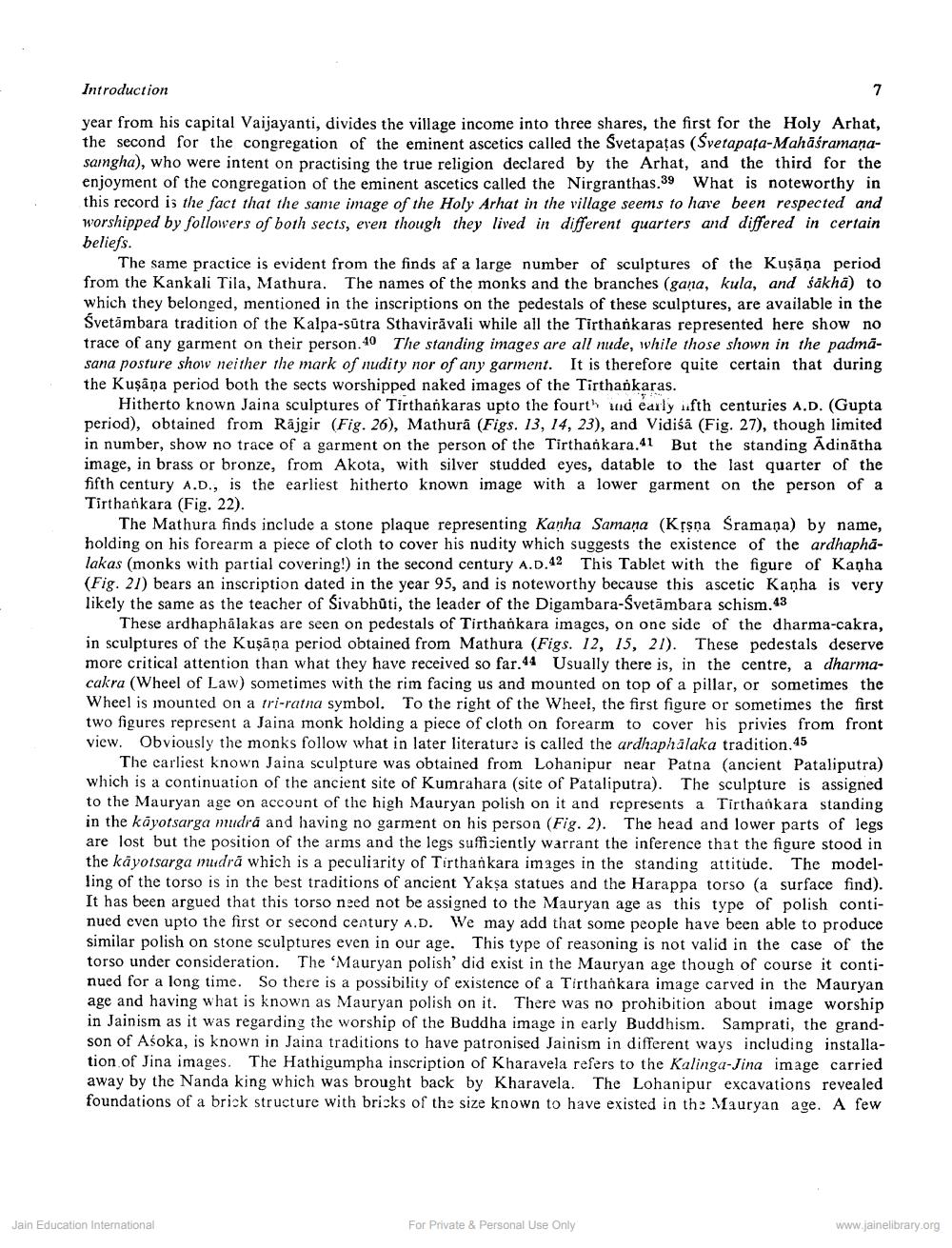________________
Introduction
year from his capital Vaijayanti, divides the village income into three shares, the first for the Holy Arhat, the second for the congregation of the eminent ascetics called the Svetapatas (Śvetapata-Mahāśramanasamgha), who were intent on practising the true religion declared by the Arhat, and the third for the enjoyment of the congregation of the eminent ascetics called the Nirgranthas.39 What is noteworthy in this record is the fact that the same image of the Holy Arhat in the village seems to have been respected and worshipped by followers of both sects, even though they lived in different quarters and differed in certain beliefs.
The same practice is evident from the finds af a large number of sculptures of the Kuṣāṇa period from the Kankali Tila, Mathura. The names of the monks and the branches (gana, kula, and śākhā) to which they belonged, mentioned in the inscriptions on the pedestals of these sculptures, are available in the Śvetambara tradition of the Kalpa-sutra Sthaviravali while all the Tirthankaras represented here show no trace of any garment on their person.40 The standing images are all nude, while those shown in the padmasana posture show neither the mark of nudity nor of any garment. It is therefore quite certain that during the Kuşâna period both the sects worshipped naked images of the Tirthankaras.
7
Hitherto known Jaina sculptures of Tirthankaras upto the fourth and early ifth centuries A.D. (Gupta period), obtained from Rajgir (Fig. 26), Mathura (Figs. 13, 14, 23), and Vidiśā (Fig. 27), though limited in number, show no trace of a garment on the person of the Tirthankara.41 But the standing Adinatha image, in brass or bronze, from Akota, with silver studded eyes, datable to the last quarter of the fifth century A.D., is the earliest hitherto known image with a lower garment on the person of a Tirthankara (Fig. 22).
The Mathura finds include a stone plaque representing Kanha Samana (Kṛṣṇa Śramana) by name, holding on his forearm a piece of cloth to cover his nudity which suggests the existence of the ardhaphalakas (monks with partial covering!) in the second century A.D.42 This Tablet with the figure of Kanha (Fig. 21) bears an inscription dated in the year 95, and is noteworthy because this ascetic Kanha is very likely the same as the teacher of Sivabhuti, the leader of the Digambara-Svetämbara schism.43
These ardhaphalakas are seen on pedestals of Tirthankara images, on one side of the dharma-cakra, in sculptures of the Kuşaṇa period obtained from Mathura (Figs. 12, 15, 21). These pedestals deserve more critical attention than what they have received so far.44 Usually there is, in the centre, a dharmacakra (Wheel of Law) sometimes with the rim facing us and mounted on top of a pillar, or sometimes the Wheel is mounted on a tri-ratna symbol. To the right of the Wheel, the first figure or sometimes the first two figures represent a Jaina monk holding a piece of cloth on forearm to cover his privies from front view. Obviously the monks follow what in later literature is called the ardhaphalaka tradition. 45
The earliest known Jaina sculpture was obtained from Lohanipur near Patna (ancient Pataliputra) which is a continuation of the ancient site of Kumrahara (site of Pataliputra). The sculpture is assigned to the Mauryan age on account of the high Mauryan polish on it and represents a Tirthankara standing in the kayotsarga mudra and having no garment on his person (Fig. 2). The head and lower parts of legs are lost but the position of the arms and the legs sufficiently warrant the inference that the figure stood in the käyotsarga mudra which is a peculiarity of Tirthankara images in the standing attitude. The modelling of the torso is in the best traditions of ancient Yakṣa statues and the Harappa torso (a surface find). It has been argued that this torso need not be assigned to the Mauryan age as this type of polish continued even upto the first or second century A.D. We may add that some people have been able to produce similar polish on stone sculptures even in our age. This type of reasoning is not valid in the case of the torso under consideration. The 'Mauryan polish' did exist in the Mauryan age though of course it continued for a long time. So there is a possibility of existence of a Tirthankara image carved in the Mauryan age and having what is known as Mauryan polish on it. There was no prohibition about image worship in Jainism as it was regarding the worship of the Buddha image in early Buddhism. Samprati, the grandson of Asoka, is known in Jaina traditions to have patronised Jainism in different ways including installation of Jina images. The Hathigumpha inscription of Kharavela refers to the Kalinga-Jina image carried away by the Nanda king which was brought back by Kharavela. The Lohanipur excavations revealed foundations of a brick structure with bricks of the size known to have existed in the Mauryan age. A few
Jain Education International
For Private & Personal Use Only
www.jainelibrary.org




